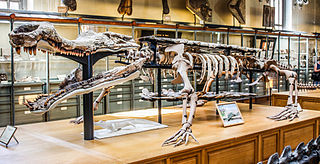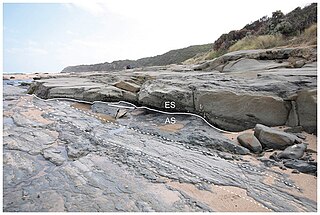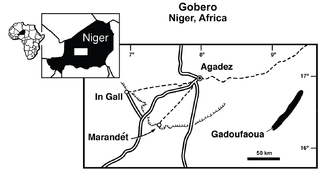
Sarcosuchus is an extinct genus of crocodyliform and distant relative of living crocodilians that lived during the Early Cretaceous, from the late Hauterivian to the early Albian, 133 to 112 million years ago of what is now Africa and South America. The genus name comes from the Greek σάρξ (sarx) meaning flesh and σοῦχος (souchus) meaning crocodile. It was one of the largest pseudosuchians, with the largest specimen of S. imperator reaching approximately 9–9.5 metres (29.5–31.2 ft) long and weighing up to 3.45–4.3 metric tons. It is known from two species; S. imperator from the early Albian Elrhaz Formation of Niger, and S. hartti from the Late Hauterivian of northeastern Brazil. Other material is known from Morocco and Tunisia and possibly Libya and Mali.

Aegyptosaurus is a genus of sauropod dinosaur that lived in what is now Africa, around 95 million years ago, during the Late Cretaceous Period.

Rebbachisaurus is a genus of sauropod dinosaur of the superfamily Diplodocoidea, that lived during the Late Cretaceous period in Africa and possibly also South America about 99-97 million years ago. Remains attributed to Rebbachisaurus have been found in Morocco, Niger, Algeria, Tunisia and possibly also Argentina, although only the Moroccan remains can be referred to the genus without doubt. The discovery of Rayososaurus, a South American sauropod nearly identical to Rebbachisaurus which may have actually have been the same animal as Rebbachisaurus, supports the theory that there was still a land connection between Africa and South America during the Early Cretaceous, long after it was commonly thought the two continents had separated.

Rebbachisauridae is a family of sauropod dinosaurs known from fragmentary fossil remains from the Cretaceous of South America, Africa, North America, Europe and possibly Central Asia.

Machimosaurus is an extinct genus of machimosaurid crocodyliform from the Late Jurassic and Early Cretaceous. The type species, Machimosaurus hugii, was found in Switzerland. Other fossils have been found in England, France, Germany, Portugal, Switzerland and Tunisia. Machimosaurus rex is the largest named teleosauroid and thalattosuchian, with an estimated length of up to 7.15 m (23.5 ft). Machimosaurus is the largest known crocodyliform of the Jurassic.
Ferganoceratodus is a genus of prehistoric lungfish known from the Mesozoic of Asia. Based on morphological evidence, it has either been recovered as a basal member of the Ceratodontiformes or to be the sister group of the Neoceratodontidae.
The Continental intercalaire, sometimes referred to as the Continental intercalaire Formation, is a term applied to Cretaceous strata in Northern Africa. It is the largest single stratum found in Africa to date, being between 30 and 800 metres thick in some places. Fossils, including dinosaurs, have been recovered from this formation. The Continental intercalaire stretches from Algeria, Tunisia and Niger in the west to Egypt and Sudan in the east.
The Chenini Member is a geological member of the Ain el Guettar Formation in Tunisia, whose strata date back to the Late Aptian to Early Albian stages of the Cretaceous period. The lithology consists of coarse sandstones with occasional conglomerates and mudstones. Dinosaur remains are among the fossils that have been recovered from the formation.
The Dinosaur Beds is a geological formation in Malawi whose strata date back to the Early Cretaceous. The age of the deposit is poorly constrained, but is likely to date from the Barremian to Aptian. Dinosaurs, turtles and crocodylomorphs remains are among the fossils that have been recovered from the formation. It is correlated with the Galula Formation in Tanzania. It consists of two members, a lower unfossiliferous member consisting of deep red stained sandstones, and an upper fossiliferous member consisting of white sands and grey to red mudstones and siltstones. The upper member is 210 m thick in the vicinity of the CD-9 locality.
The Griman Creek Formation is a geological formation in northern New South Wales and southern Queensland, Australia whose strata date back to the Albian-Cenomanian stages of the mid-Cretaceous. It is most notable being a major source of opal, found near the town of Lightning Ridge, New South Wales. Alongside the opal opalised fossils are also found, including those of dinosaurs and primitive monotremes.

The Eumeralla Formation is a geological formation in Victoria, Australia whose strata date back to the Early Cretaceous. It is Aptian to Albian in age. Dinosaur remains are among the fossils that have been recovered from the formation, particularly from the Dinosaur Cove locality.
The Wapiti Formation is a geological formation of the Western Canada Sedimentary Basin in northwestern Alberta, and northeastern British Columbia, Canada. Its deposition spanned the time interval from the lower Campanian through to the upper Maastrichtian, between approximately 80 and 68 Ma. It was named by G.M. Dawson in 1881, presumably for exposures along the lower part of the Wapiti River and downstream along the Smoky River in Alberta.

The Elrhaz Formation is a geological formation in Niger, West Africa.
The Douiret Formation is a geologic formation in Tunisia, near the Berber village of Douiret. It is part of the larger Continental Intercalaire Formation, which stretches from Algeria and Niger in the west to Egypt and Sudan in the east. The Douiret Formation is located in the Tataouine basin in southern Tunisia, stretching into Algeria and Libya, and is part of the Merbah el Asfer Group of rock formations. The Douiret is 80 metres thick and consists of a 30-metre layer of sand beneath a 50-metre layer of clay.
Tataouinea is an extinct genus of sauropod dinosaur in the subfamily Rebbachisaurinae of Rebbachisauridae which lived in the Early Cretaceous of Tunisia. Only one species, T. hannibalis, is known.
Shingopana is a genus of titanosaurian sauropod from the Upper Cretaceous Galula Formation of Tanzania. It is known from only the type species, S. songwensis. Gorscak & O'Connor's phylogenetic testing suggest Shingopana is more closely related to the South American titanosaur family of Aeolosaurini than any of the titanosaurs found so far in North & South Africa.
The Quseir Formation is a geological formation in the vicinity of the Kharga Oasis in Egypt. It is Campanian In age. The lithology largely consists of soft shale with hard bands of sandstone, siltstone and phosphorite. The environment of deposition was nearshore to freshwater fluvio-lacustrine characterized by moist and aquatic habitats with a tropical warm-humid climate. It is conformably overlain by the marine late Campanian-Maastrichtian Duwi Formation, and unconformably overlies the Turonian Taref Formation. The sauropod dinosaurs Mansourasaurus and Igai are known from the formation, as well as the proximal fibula of an indeterminate theropod. Additionally the lungfish genera Lavocatodus and Protopterus, the crocodyliform Wahasuchus and the bothremydid turtle Khargachelys are also known.
The Galula Formation is a geological formation located south of Lake Rukwa in Tanzania, part of the Red Sandstone Group of the Rukwa Rift Basin. Along with the unconformably overlying Oligocene Nsungwe Formation. It is divided into two members, the lower Mtuka Member and the upper Namba Member.
The Aïn el Guettar Formation is a geological formation in Tunisia, whose strata date back to the Late Aptian to Early Albian stages of the Cretaceous period. The lithology consists of coarse sandstones with occasional conglomerates and mudstones. Dinosaur remains are among the fossils that have been recovered from the formation.

Meraxes is a genus of large carcharodontosaurid theropod dinosaur from the Late Cretaceous Huincul Formation of Patagonia, Argentina. The genus contains a single species, Meraxes gigas.








